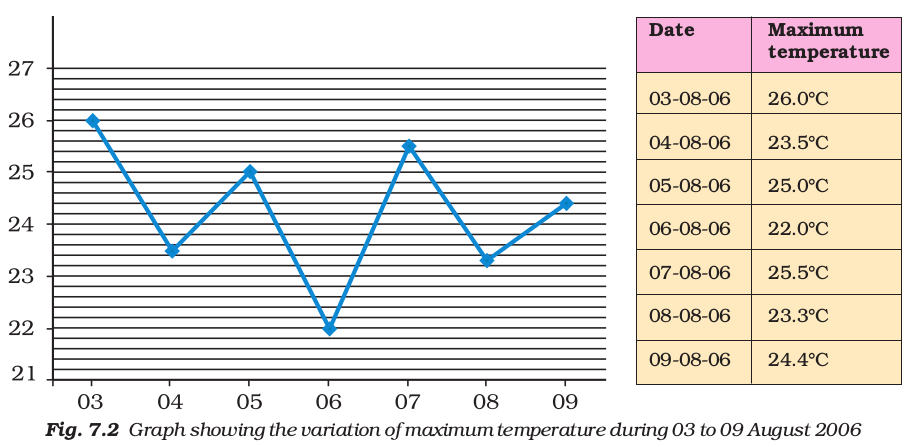Table of Contents

7. Weather, Climate and Adaptations of Animals to Climate
In this chapter, we will study about the weather and climate. We will also see how different forms of life are adapted to the climate of their habitat.
7.1 Weather
In Fig. 7.1 a sample of weather report from a newspaper is given.
We find that the daily weather report carries information about the temperature, humidity and rainfall during the past 24 hours. It also predicts the weather for the day. Humidity, as you might know, is a measure of the moisture in air.

Fig. 7.1 A sample of a weather report from a newspaper

The weather reports are prepared by the Meteorological Department of the Government. This department collects data on temperature, wind, etc., and makes the weather prediction. |
Activity 7.1
Cut out the weather reports of the last week from any newspaper. If you do not get a newspaper at home borrow from your neighbours or friends and copy these reports in your notebook. You can also collect weather reports from a library. Paste all the cut-outs on a white sheet or on a chart paper.
Now record the information from the weather reports collected by you in
Table 7.1. The first row is just a sample. Fill all the columns according to the data in the chart that you have prepared.
Table 7.1
Weather data of a week
| Date | Max.temp. (°C) | Min.temp. (°C) | Min.humidity (%) | Max.humidity(%) | Rainfall*(mm) |
| 23-08-06 | 36.2 | 27.8 | 54 | 82 | |
*(Rainfall may not be recorded for all the days since it may not rain everyday. Leave the space for rainfall blank if the data is not available.)
Rainfall is measured by an instrument called the rain gauge. It is basically a measuring cylinder with a funnel on top to collect rainwater. |
Do all the seven days have the same maximum and minimum temperatures, humidity and rainfall? The maximum and minimum temperatures recorded may be the same for some of the days. However, all the parameters are not the same on any two days. Over a week there may be considerable variation. The day-to-day condition of the atmosphere at a place with respect to the temperature, humidity, rainfall, wind-speed, etc., is called the weather at that place. The temperature, humidity, and other factors are called the elements of the weather. The weather of a place changes day after day and week after week. That is why we often say, “today’s weather is too humid”, or “the weather was warm last week”.
Look at the graph given below which shows the maximum temperature recorded during 03 August 2006 to 09 August 2006 at Shillong, Meghalaya (Fig. 7.2).
As it is clear from any weather report, the maximum and minimum temperatures are recorded every day. Do you know how these temperatures are recorded. In Chapter 4 you have learnt that there are special thermometers for this purpose, called maximum and minimum thermometers. Can you guess when during the day we have the maximum temperature and when the minimum?
The maximum temperature of the day occurs generally in the afternoon while the minimum temperature occurs generally in the early morning. Can you now understand why in summers we feel so miserable in the afternoon and comparatively comfortable early in the morning?


All changes in the weather are caused by the sun. The sun is a huge sphere of hot gases at a very high temperature. The distance of the sun from us is very large. Even then the energy sent out by the sun is so huge that it is the source of all heat and light on the earth. So, the sun is the primary source of energy that causes changes in the weather. Energy absorbed and reflected by the earth’s surface, oceans and the atmosphere play important roles in determining the weather at any place. If you live near the sea, you would have realised that the weather at your place is different from that of a place in a desert, or near a mountain. |
What about the times of sunrise and sunset? You know that in winters it becomes dark early and you do not get much time to play. Are the days shorter in winter than in summer? Try to find it out yourself by completing the project given at the end of the chapter.
7.2 Climate
In Table 7.2 and 7.3, we have given the climatic condition at two places in India. The mean temperature for a given month is found in two steps. First we find the average of the temperatures recorded during the month. Second, we calculate the average of such average temperatures over many years. That gives the mean temperature. The two places are: Srinagar in Jammu and Kashmir, and Thiruvananthapuram in Kerala.

(Note: The numbers for the mean total rainfall have been rounded off)
By looking at Tables 7.2 and 7.3 we can easily see the difference in the climate of Jammu & Kashmir and Kerala. We can see that Kerala is very hot and wet in comparison to Jammu & Kashmir, which has a moderately hot and wet climate for a part of the year.
7.3 Climate and Adaptation
Climate has a profound effect on all living organisms.
Animals are adapted to survive in the conditions in which they live. Animals living in very cold and hot climate must possess special features to protect themselves against the extreme cold or heat. Recall from Chapter 9 of your Class VI science book the definition of adaptation. Features and habits that help animals to adapt to their surroundings are a result of the process of evolution.
In Chapter 9 you will learn about the effect of weather and climate on soil. Here we will study the effect of climate on animals only. In Class VI, you have read about adaptations of animals to certain habitats. As examples of adaptation of animals to climatic conditions, we discuss only animals living in polar regions and tropical rainforests.
As the name suggests, the polar regions are situated near the poles, i.e., north pole and south pole.
Some well-known countries that belong to the polar regions are Canada, Greenland, Iceland, Norway, Sweden, Finland, Alaska in U.S.A. and Siberian region of Russia.
Examples of some countries where the tropical rainforests are found are India, Malaysia, Indonesia, Brazil, Republic of Congo, Kenya, Uganda, and Nigeria.
Activity 7.2
Take an outline map of the world. Mark the polar regions in blue. Similarly, mark the tropical regions in red.
(i) The polar regions
The polar regions present an extreme climate. These regions are covered with snow and it is very cold for most part of the year. For six months the sun does not set at the poles while for the other six months the sun does not rise. In winters, the temperature can be as low as –37°C. Animals living there have adapted to these severe conditions. Let us see how they are adapted by considering the examples of polar bears and penguins.
Polar bears have white fur so that they are not easily visible in the snowy white background. It protects them from their predators. It also helps them in catching their prey. To protect them from extreme cold, they have two thick layers of fur. They also have a layer of fat under their skin. In fact, they are so well-insulated that they have to move slowly and rest often to avoid getting overheated.
Physical activities on warm days necessitate cooling. So, the polar bear goes for swimming. It is a good swimmer. Its paws are wide and large, which help it not only to swim well but also walk with ease in the snow. While swimming under water, it can close its nostrils and can remain under water for long durations. It has a strong sense of smell so that it can catch its prey
for food. We can understand the adaptations of polar bears with the help of the flow chart shown in Fig. 7.3.

Fig. 7.3 Adaptations of polar bear
Another well-known animal living in the polar regions is the penguin
(Fig. 7.4). It is also white and merges well with the white background. It also has a thick skin and a lot of fat to protect it from cold. You may have seen pictures of penguins huddled together. This they do to keep warm. Recall how warm you feel when you are in a hall full of people. Like polar bears, penguins are also good swimmers. Their bodies are streamlined and their feet have webs, making them good swimmers (Fig. 7.5).

Fig. 7.4 Penguins huddled together

Fig. 7.5 Feet of penguin
Other animals living in the polar regions are many types of fishes, musk oxen, reindeers, foxes, seals, whales, and birds. It is to be noted that while fish can remain under cold water for long, birds must remain warm to survive. They migrate to warmer regions when winter sets in. They come back after the winter is over. You know probably that India is one of the destinations of many of these birds. You must have seen or heard about the Siberian crane that comes from Siberia to places like Bharatpur in Rajasthan and Sultanpur in Haryana, and some wetlands of north east and some other parts of India (Fig. 7.6).



Fig. 7.6 Migratory birds in their habitat/ Migratory birds in flight
| Did you know? |
Some migratory birds travel as much as 15000 km to escape the extreme climatic conditions at home. Generally they fly high where the wind flow is helpful and the cold conditions allow them to disperse the heat generated by their flight muscles. But how these birds travel to the same place year after year is still a mystery. It seems that these birds have a built–in sense of direction and know in which direction to travel. Some birds probably use landmarks to guide them. Many birds may be guided by the sun during the day and stars at night. There is some evidence that birds may use the magnetic field of the earth to find direction. And it is not only birds that migrate; mammals, many types of fish and insects are also known to migrate seasonally in search of more hospitable climates. |
(ii) The tropical rainforests
The tropical region has generally a hot climate because of its location around the equator. Even in the coldest month the temperature is generally higher than about 15°C. During hot summers, the temperature may cross 40°C. Days and nights are almost equal in length throughout the year. These regions get plenty of rainfall. An important feature of this region is the tropical rainforests. Tropical rainforests are found in Western Ghats and Assam in India, Southeast Asia, Central America and Central Africa. Because of continuous warmth and rain, this region supports wide variety of plants and animals. The major types of animals living in the rainforests are monkeys, apes, gorillas, tigers, elephants, leopards, lizards, snakes, birds and insects.
Let us read about the adaptations of these animals to a hot, humid climate.
The climatic conditions in rainforests are highly suitable for supporting an enormous number and a variety of animals.
Since the numbers are large, there is intense competition for food and shelter. Many animals are adapted to living on the trees. Red-eyed frog (Fig. 7.7) has developed sticky pads on its feet to help it climb trees on which it lives. To help them live on the trees, monkeys (Fig. 7.8) have long tails for grasping branches. Their hands and feet are such that they can easily hold on to the branches.

Fig. 7.7 Red-eyed frog

Fig. 7.8 A new world monkey
As there is competition for food, some animals are adapted to get food not easily reachable. A striking example is that of the bird Toucan (Fig. 7.9), which possesses a long, large beak. This helps a toucan to reach the fruits on branches which are otherwise too weak to support its weight.

Fig. 7.9 Toucan

Many tropical animals have sensitive hearing, sharp eyesight, thick skin and a skin colour which helps them to camouflage by blending with the surroundings. This is to protect them from predators. For example, big cats (lions and tigers) have thick skins and sensitive hearing.
The lion-tailed macaque (also called Beard ape) lives in the rainforests of Western Ghats (Fig. 7.10). Its most outstanding feature is the silver-white mane, which surrounds the head from the cheeks down to its chin. It is a good climber and spends a major part of its life on the tree. It feeds mainly on fruits. It also eats seeds, young leaves, stems, flowers and buds. This beard ape also searches for insects under the bark of the trees. Since it is able to get sufficient food on the trees, it rarely comes down on the ground.
Another well-known animal of Indian tropical rainforest is the elephant (Fig. 7.11). It has adapted to the conditions of rainforests in many remarkable ways. Look at its trunk. It uses it as a nose because of which it has a strong sense of smell. The trunk is also used by it for picking up food. Moreover, its tusks are modified teeth. These can tear the bark of trees that elephant loves to eat. So, the elephant is able to handle the competition for food rather well. Large ears of the elephant help it to hear even very soft sounds. They also help the elephant to keep cool in the hot and humid climate of the rainforest.

| Keywords | ||
| Adaptation | Maximum temperature | Tropical rainforest |
| Climate | Migration | Tropical region |
| Elements of weather | Minimum temperature | Weather |
| Humidity | Polar region |
| What you have learnt |
|
Exercises
1. Name the elements that determine the weather of a place.
2. When are the maximum and minimum temperatures likely to occur during the day?
3. Fill in the blanks:
(i) The average weather taken over a long time is called ___________.
(ii) A place receives very little rainfall and the temperature is high throughout the year, the climate of that place will be ___________ and ___________ .
(iii) The two regions of the earth with extreme climatic conditions are ___________ and __________.
4. Indicate the type of climate of the following areas:
(a) Jammu and Kashmir: _________________________________
(b) Kerala: ____________________________________________
(c) Rajasthan: __________________________________________
(d) North-east India: _____________________________________
5. Which of the two changes frequently, weather or climate?
6. Following are some of the characteristics of animals:
(i) Diets heavy on fruits (ii) White fur
(iii) Need to migrate (iv) Loud voice
(v) Sticky pads on feet (vi) Layer of fat under skin
(vii) Wide and large paws (viii) Bright colours
(ix) Strong tails (x) Long and large beak
For each characteristic indicate whether it is adaptation for tropical rainforests or polar regions. Do you think that some of these
characteristics can be adapted for both regions?
7. The tropical rainforest has a large population of animals. Explain why it is so.
8. Explain, with examples, why we find animals of certain kind living in particular climatic conditions.
9. How do elephant living in the tropical rainforest adapt itself?
Choose the correct option which answers the following question:
10. A carnivore with stripes on its body moves very fast while catching its prey. It is likely to be found in
(i) polar regions (ii) deserts
(iii) oceans (iv) tropical rainforests
11. Which features adapt polar bears to live in extremely cold climate?
(i) A white fur, fat below skin, keen sense of smell.
(ii) Thin skin, large eyes, a white fur.
(iii) A long tail, strong claws, white large paws.
(iv) White body, paws for swimming, gills for respiration.
12. Which option best describes a tropical region?
(i) hot and humid
(ii) moderate temperature, heavy rainfall
(iii) cold and humid
(iv) hot and dry
Extended Learning — Projects and Activities
1. Collect weather reports of seven successive days in the winter months (preferably December). Collect similar reports for the summer months (preferably June). Now prepare a table for sunrise and sunset times as shown:

Try to answer the following questions:
(i) Is there any difference in the time of sunrise during summer and winter?
(ii) When do you find that the sun rises earlier?
(iii) Do you also find any difference in the time of sunset during the month of June and December?
(iv) When are the days longer?
(v) When are the nights longer?
(vi) Why are the days sometimes longer and sometimes shorter?
(vii) Plot the length of the day against the days chosen in June and December.
(Instructions for plotting graphs are given in Chapter 13.)
2. Collect information about the Indian Meteorological Department. If possible visit its website: http//www.imd.gov.in.
Write a brief report about the things this department does.
| Did you know? |
Rainforests cover about 6% of the earth’s surface, but they have more than half of the animal life and about two-thirds of the flowering plants of the planet. However, much of this life is still unknown to us. |